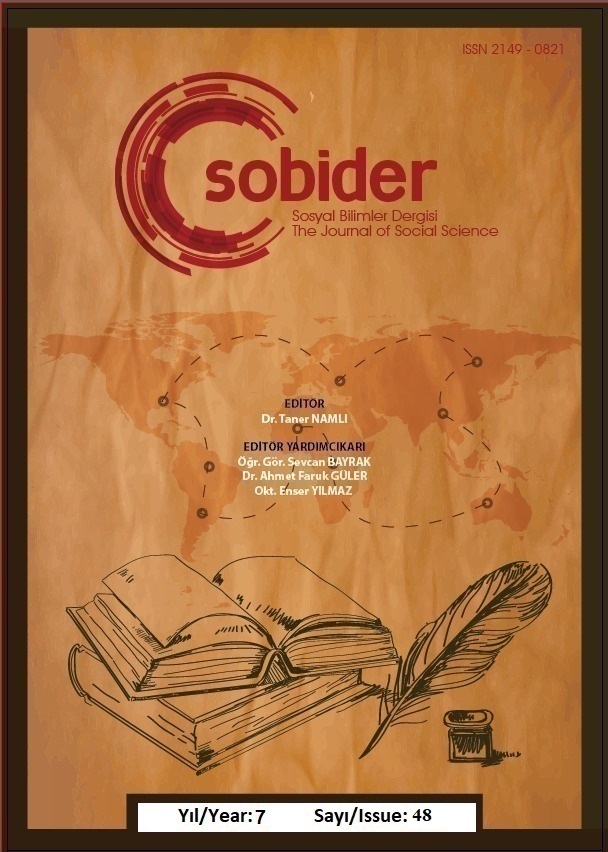Author :
Abstract
Kadı tarafından yapılan yargılamalar sonucu verilen hükümlerin, merkezden gönderilen yazıların ve kadıların birbirleriyle veya diğer idarecilerle yaptıkları yazışmaları ihtiva eden defterlere Şer’iyye Sicilleri denir. Sosyal hayatın bütün yönlerinden izlerin bulunduğu Şer’iyye Sicilleri, Osmanlı toplumsal yapısına dair yapılan araştırmalarda önemli bir yere sahiptir. Özellikle konumuzla ilgili olan evlenme, boşanma, gibi konular açısından en detaylı belgelerin bulunduğu defterlerdir. Aile kavramı, değişik toplumlarda, farklı bilimsel alanlarda değişik biçimlerde tanımlanmaktadır. Ancak aile, genel bir ifade ile bir kadın ve erkeğin evlenmesi sonucunda oluşan en temel toplumsal birime verilen addır. Toplum yapısının en küçük birimi olarak nitelendirilen aile, var olduğu zaman ve mekân içerisinde dini, kültürel, ekonomik, sosyal ve siyasi birçok etkenin güdümü altında kalmıştır. Bundan dolayıdır ki, farklı toplumlarda farklı aile modelleri görülmüştür. Bu bağlamda çalışmamızda, Urfa Şer’iyye Sicillerine dayanarak XIX. yüzyılda Urfa’daki aile yapısı incelenecektir. Çalışma kapsamında, Urfa’da Müslüman ve gayr-i Müslimlerin evlilikleri ve evlenme şekilleri, yine Müslüman bir aile ve gayr-i Müslim bir aile arasında eş sayısı ve çocuk sayısı bakımından bir farkın olup olmadığı, tespit edilmeye çalışılmıştır. Keza, şehrin etnik zenginliğe sahip olması ve farklı kültürlerin ve inançların bir arada bulunması, Urfa’daki aile yapısını değişik açılardan değerlendirmemize katkı sağlayacaktır.
Keywords
Abstract
The records including the provisions resulting from the proceedings made by Kadi, the letters sent from the center and the correspondences between the Kadi and the other administrators, are referred to as “Şer’iyye Sicilleri” meaning court records in English. Shar’iyyah Records, which have traces of all aspects of social life, have an important role in the researches about the Ottoman social structure. In particular, they are the records which have the most detailed documents related to our issues such as marriage, divorce. The concept ‘family’ has different definitions in different societies and in different scientific fields. However, the ‘family’ in general terms means the most basic social unity resulted from the marriage of a woman and a man. The family, which is regarded as the smallest unit of social structure, is under the control of many religious, cultural, economic, social and political factors depending on when and where they exist. That is why different family models have been observed in different societies. In this context, based on Urfa Shar’iyyah Records, the family structure in Urfa in the 19th century will be analysed in our study. Within the scope of the study, it was intended to examine the marriages and marriage patterns of Muslims and non-Muslims in Urfa, whether there is a difference in terms of the number of spouses between a Muslim family and a non-Muslim family as well as the number of children. Likewise, the fact that the city has an ethnic richness and that different cultures and beliefs coexist will contribute to the evaluation of the family structure in Urfa from different perspectives.
Keywords
- 2. Araştırma ve İncelemelerAkgündüz, A. (1988). Şer‘iye Sicilleri (Mahiyeti, Toplu Kataloğu ve Seçme Hükümler), C.I TDAV. Yayınları, İstanbul.
- Atar, F. (2007). “Nikâh”, TDV İslam Ansiklopedisi, C.33, İstanbul, s.112-117.
- Aydın, M. Â. (1996). İslâm ve Osmanlı Hukuku Araştırmaları, İz Yayınları, İstanbul.
- Eken, G. (2000). “XVIII. Yüzyıl Ortalarında Antep’te Aile”, Sosyal Bilimler Enstitüsü Dergisi, S.6, Konya, s.477-490.
- Güler, İ. (2002). “XVIII. Yüzyılda Aile: Sinop”, Türkler, Yeni Türkiye Yayınları, C.XIV, Ankara, s.28-40.
- Gündüz, A. (2003). “XVIII. Yüzyılın Son Çeyreğinde Kayseri’de Aile, Evlilik ve Çocuk Sayıları 1775-1800”, IV. Kayseri ve Yöresi Tarih Sempozyumu, Kayseri.
- Bayraktar, H. (2007). Tanzimat’tan Cumhuriyet’e Urfa Sancağı, Fırat Üniversitesi Orta Doğu Araştırmaları Merkezi Yayınları, No:14, Elazığ.
- Cin, H. ve Akgündüz, A. (1990). Türk Hukuk Tarihi, C.II, Timaş Yayınları, İstanbul.
- Cin H. (1974). İslâm ve Osmanlı Hukukunda Evlenme, Ankara Üniversitesi Hukuk Fakültesi Yayınları, Ankara.
- Devellioğlu, F. (2013). Osmanlıca-Türkçe Ansiklopedik Lûgat, Ak Aydın Kitabevi, Ankara.
- Dinç, G. (2005). “Şer’iyye Sicillerine Göre XIX. Yüzyıl Ortalarında Antalya’da Aile’nin Sosyo- Ekonomik Durumu”, OTAM, S.17, s.1-19.
- Gökçe, E. (2014). “XIX. Yüzyılın İlk Yarısında Hamid Sancağında Ailenin Oluşumu ÜzerineBazı Gözlemler”, Süleyman Demirel Üniversitesi Sosyal Bilimler Enstitüsü Dergisi, S.19, Isparta, s.35-72.
- Güriz, A. ve Benedict, P. (1974). Türk Hukuku ve Toplumu Üzerine İncelemeler, Türkiye Kalkınma Vakfı Yayınları No:1, Ankara.
- Haykır, Y. ve Handan, H. (2017). “Tarihsel Süreç İçerisinde Türk Aile Yapısına Bir Bakış”, Türk Dünyası Araştırmaları Dergisi, C.117, S.230, s.87-106.
- Haykır, Y. (2017). “Türk Medeni Kanunu’nun Kabulü ve Türk Aile Hukuku”, Cappadocia Journal of History and Social Sciences, S.9, s.575-594.
- İlgürel, M. (1975). “Şer’iyye Sicilleri Toplu Kataloğuna Doğru”, Tarih Dergisi, S.28-29, İstanbul.
- İnalcık, H. 1958). “Osmanlı Hukukuna Giriş: Örfî-Sultanî Hukuk ve Fatih’in Kanunları”, Ankara Üniversitesi Siyasal Bilgiler Fakültesi Dergisi, C. XIII, Ankara, s.102-126.
- Karaman, H. (1975). Başlangıçta Dördüncü Asra Kadar İslam Hukukunda İçtihad, Diyanet İşleri Başkanlığı Yayınları, Ankara.
- Okuducu, G. (2015). Osmanlı’dan Cumhuriyete Türk Kadınının Kısa Tarihi, Kaynak Yayınları,Ortaylı İ. (1991). “Osmanlı Toplumunda Ailenin Yeri”, Türk Aile Ansiklopedisi, C.I, Ankara.Ortaylı, İ. (2000). “Osmanlı Toplumunda Aile”, Osmanlı İmparatorluğu’nda İktisadi ve Sosyal Değişim, Makaleler I, Turhan Kitabevi, Ankara.
- Ortaylı, İ. (2000). Osmanlı Toplumunda Aile, Pan Yayıncılık, İstanbul.
- Özkiraz, A. ve Baş, G.İ. (2016). “Osmanlıdan Günümüze Türk Toplumunda Aile Yapısı ve Boşanma”, KMÜ Sosyal ve Ekonomik Araştırmalar Dergisi, 18 (30), s.87-95.
- Öztürk, M. (2014). Tarih Felsefesi, Akçağ Yayınları, Ankara.
- Taş, Y. (2013). Kadı Sicillerine Göre XIX. Yüzyılda Urfa’da Sosyal Hayat, Marmara Üniversitesi Sosyal Bilimler Enstitüsü (Basılmamış Doktora Tezi), İstanbul.
